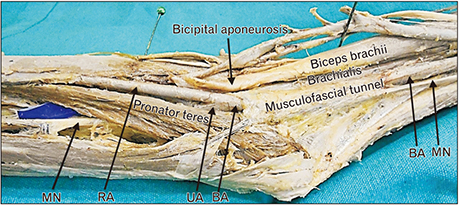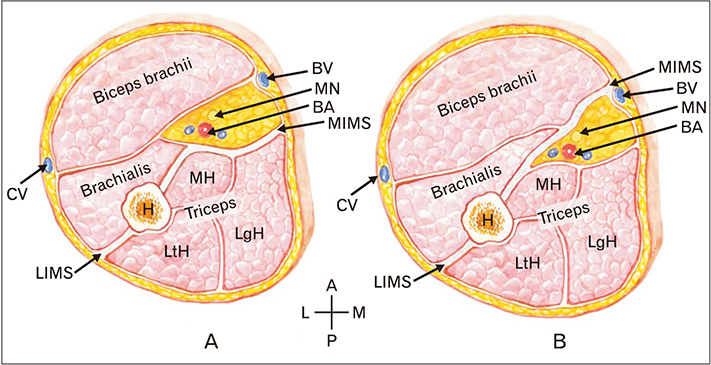Anat Cell Biol.
2019 Mar;52(1):84-86. 10.5115/acb.2019.52.1.84.
Rare case of median nerve and brachial artery entrapment by an abnormal musculo-fascial tunnel in the arm: possible cause of neurovascular compression syndrome
- Affiliations
-
- 1Department of Anatomy, Melaka Manipal Medical College (Manipal Campus), Manipal Academy of Higher Education, Manipal, India. ashwini.anat@gmail.com
- 2Department of Anatomy, Srinivas Institute of Medical Sciences and Research Center, Mukka, India.
- KMID: 2442334
- DOI: http://doi.org/10.5115/acb.2019.52.1.84
Abstract
- Entrapment neuropathies of the peripheral nervous system are frequently encountered due to anatomical variations. Median nerve is the most vulnerable nerve to undergo entrapment neuropathies. The clinical complications are mostly manifested by median nerve impingement in forearm and wrist areas. Median nerve entrapment could also occur at the arm, due to the presence of ligament of Struthers. Here we report a rare case of proximal entrapment of median nerve and brachial artery in the arm by an abnormally formed musculo-fascial tunnel. The tunnel was formed by the muscle fibers of brachialis and medial intermuscular septum in the lower part of arm. Due to this, the median nerve coursed deep, below the tunnel and continued distally into the forearm, underneath the pronator teres muscle and hence did not appear as a content of cubital fossa. The present entrapment of neurovascular structures in the tunnel might lead to pronator syndromes or other neurovascular compression syndromes.
MeSH Terms
Figure
Reference
-
1. Standring S, Borley NR, Collins P, Crossman AR, Gatzoulis MA, Healy JC, Johnson D, Mahadevan V, Newell RL, Wigley CB. Gray's anatomy: the anatomical basis of clinical practice. 40th ed. London: Churchill Livingstone;2008. p. 825–828.2. Bilecenoglu B, Uz A, Karalezli N. Possible anatomic structures causing entrapment neuropathies of the median nerve: an anatomic study. Acta Orthop Belg. 2005; 71:169–176.3. De Jesus R, Dellon AL. Historic origin of the “Arcade of Struthers”. J Hand Surg Am. 2003; 28:528–531.
Article4. Lacey SH, Soldatis JJ. Bilateral pronator syndrome associated with anomalous heads of the pronator teres muscle: a case report. J Hand Surg Am. 1993; 18:349–351.
Article5. Mas N, Pelin C, Zagyapan R, Bahar H. Unusual relation of the median nerve with the accessory head of the biceps brachii muscle: an original case report. Int J Morphol. 2006; 24:561–564.
Article6. Melanie RD, Anitha G, Naveen K, Satheesha BN. Sub-brachialis course of the median nerve in the arm and its possible clinical complications: a case report. J Surg Acad. 2012; 2:52–55.7. Biswas S, Adhikari A, Kundu P. Variations in the cubital fossa. Int J Anat Var. 2010; 3:122–124.8. Shetty SD, Nayak SB, Kumar N, Guru A. Unusual cubital fossa anatomy: case report. Anat J Afr. 2013; 2:80–83.9. Meda N, Verma H, Tripathi RK. Ischemic brachial artery entrapment syndrome by supracondylar humeral bony spur. J Vasc Surg Cases. 2015; 1:116–119.
Article10. Padur AA, Kumar N, Shanthakumar SR, Shetty SD, Prabhu GS, Patil J. Unusual and unique variant branches of lateral cord of brachial plexus and its clinical implications: a cadaveric study. J Clin Diagn Res. 2016; 10:AC01–AC04.
Article11. Bhanu PS, Sankar KD. Bilateral absence of musculocutaneous nerve with unusual branching pattern of lateral cord and median nerve of brachial plexus. Anat Cell Biol. 2012; 45:207–210.
Article
- Full Text Links
- Actions
-
Cited
- CITED
-
- Close
- Share
- Similar articles
-
- Radial nerve neuropathy
- Nerve Compression Syndromes of the Upper Extremities
- Thrombosed Persistent Median Artery with Bifid Median Nerve Causing Acute Carpal Tunnel Syndrome: A Case Report
- Anatomic Variations of Ligaments and Muscles Related with the Ulnar Nerve Entrapment Syndrome in the Upper Arm
- Fascial entrapment of the sural nerve and its clinical relevance



